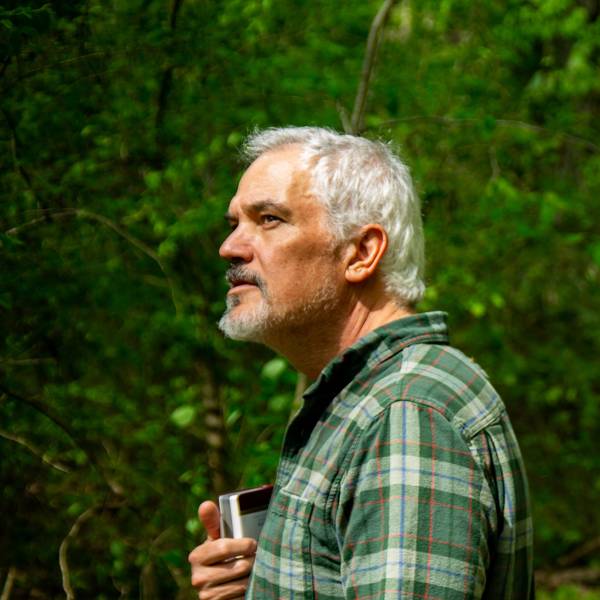How taking pictures of wildlife could help bears and elk — and people — survive outside Great Smoky Mountains National Park
People from around the country travel to Great Smoky Mountains National Park to see its majestic landscape teeming with wildlife. But unlike the millions of visitors who cross through the park gates, the animals that live in the Smokies don’t know when they are exiting the park and migrating into adjacent private lands or lands managed by the U.S. Forest Service.
Learn More on the Nature’s Edge Podcast
In the Pigeon River Gorge region just northeast of the park, dozens of large animals are wandering onto an interstate highway each year, posing serious hazards for people and wildlife alike. The road is noisy with a high volume of traffic and serves as a barrier to wildlife. Some animals try to cross and make it. Others try and fail. Many others never attempt a crossing because of the obstacle that the highway imposes.
For the last eight months, I have been working with the assistance of interns and partner organizations to use a simple technology known as camera trapping to get a remarkably useful picture of how wildlife in the Great Smoky Mountains has been traveling out of the park into the Pigeon River Gorge. This technique captures quality images of any wildlife that is large enough to trip the motion sensor — generally large mammals, though sometimes we capture pictures of birds and smaller mammals, too.
Camera trapping is an effective way to determine how wildlife behaves in its natural environment without human interference. The animals take all the pictures themselves, making the images nature’s only selfies. The cameras are totally non-intrusive and weather-resistant, so we can leave them out for months at a time, replacing the need for more biologists in the field. My team has used seven of these devices to study the habits of two species in particular, elk and black bears.
The populations of both elk and bears have grown significantly since I-40 first opened in 1969. Park Service staff reintroduced elk to Great Smoky Mountains in 2001 and 2002 after a 200-year absence; since then, the initial population of 25 animals has increased to roughly 150 animals, and this growing herd has colonized new habitat outside the park, including land on the other side of I-40. The area’s bear population, on the other hand, has increased from an estimated 275 animals in the late 1980s to an estimated 1,500 to 1,600 today. According to the North Carolina Wildlife Resources Commission, the area’s bear population is growing at 6 percent annually.
My team has been working with partners at The Wilderness Society, Defenders of Wildlife, North Carolina Wildlife Federation, Wildlands Network and the Rocky Mountain Elk Foundation to examine this corridor, determine where animals are attempting to cross I-40, and identify mortality hot spots where the most collisions occur. Last month, we engaged the help of Tony Clevenger, a renowned road ecologist from the Western Transportation Institute, to assess the data and make recommendations.
Ultimately, we plan to work collaboratively with a broad coalition of partners, including the National Park Service, the Forest Service, wildlife agencies from North Carolina and Tennessee, the Eastern Band of Cherokee, and the state departments of transportation, to gather more accurate mortality data and see if we can improve the effectiveness of existing wildlife crossing areas and examine whether new structures are needed, such as overpasses or underpasses designed for animal use. Our goal is to improve wildlife’s ability to safely cross the road. This will have a direct impact on public safety in this busy transportation corridor. The cameras have helped confirm some of the places we suspected the animals were traveling, while showing how different types of wildlife attempt different paths to approach the interstate from the park. And we’ve gotten some fantastic images of bears, bobcats, coyotes, elk and white-tailed deer in the process.
Kim DeLozier, conservation program manager for the Rocky Mountain Elk Foundation and a partner in NPCA’s work in Pigeon River Gorge, said recently of the project, “If our society has the technology and ability to put humans on the moon, I feel confident we can help our Smoky critters safely cross our roads.”
I couldn’t agree more and look forward to using the hundreds of photos we’ve captured to help build the case for better wildlife safety — and vehicle safety — in the Smokies.
About the author
-
 Jeffrey Hunter Southern Appalachian Director, Southeast, Southeast
Jeffrey Hunter Southern Appalachian Director, Southeast, SoutheastJeff Hunter is the Southern Appalachian Director with National Parks Conservation Association (NPCA) in Asheville, NC where he works on issues related to Great Smoky Mountains National Park, the Blue Ridge Parkway, and the Appalachian National Scenic Trail.
-
General
-
- NPCA Region:
- Southeast
-
Issues


